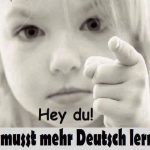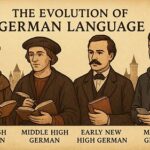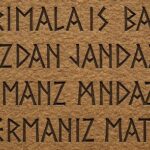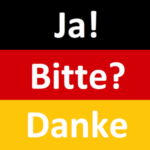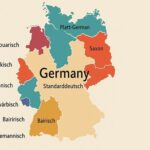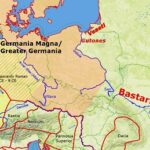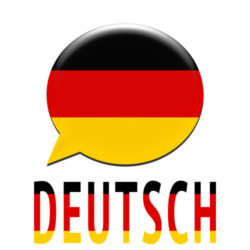 German is one of the largest groups of Indo-Germanic languages. It is used as the official language of Germany, Austria and Liechtenstein, and is a co-official language in Switzerland, Belgium, Luxembourg, and the European Union.. The history of the language begins in the Early Middle Ages with the High German consonant shift. During the migration period Old High German dialects were separated from Old Saxon.
German is one of the largest groups of Indo-Germanic languages. It is used as the official language of Germany, Austria and Liechtenstein, and is a co-official language in Switzerland, Belgium, Luxembourg, and the European Union.. The history of the language begins in the Early Middle Ages with the High German consonant shift. During the migration period Old High German dialects were separated from Old Saxon.
The earliest testimonies of Old High German are from scattered Elder Futhark inscriptions, from the 6th century AD; and the oldest coherent texts (the Hildebrandslied, the Muspilli and the Merseburg Incantations) date back to the 9th century.
During a period of several hundred years Germany was divided into many different states. Within the Holy Roman Empire the Germanic speaking area was divided into Alemannic, Bavarian, Frankish, Saxon and Frisian. The writers of that time tried to write in a way that could be understood by the people of the largest possible area. It was an important road to a unification of the language.
There are three main periods in the history of the German language:
1. Old German (c. 750 – c. 1050);
2. Middle German (c.1050 – c.1500);
3. Modern German (c.1500 to the present).
In the first period there was no standard language. The formation of the language system was influenced by the High German consonant shift. The result of this sound change is the peculiar consonant system of German, which remains different from all other West Germanic languages. But it must be admitted, that grammatical system of Old High German has much in common with Old English, Old Dutch and Old Saxon. By the mid-11th century there was a simplification of the inflectional grammar of German, caused by the reduction of vowels in unstressed syllables. That’s why 1050 is considered to be the start of the Middle High German period.
In the middle period a relatively uniform written language developed in government, but Middle High German had no standardized spelling. Different combination of certain dialects of Middle High German replaced the Latin that had been widely used in official writings of that time. Texts were written in the Latin alphabet, in Gothic minuscules.
The main features were:
1. The absence of the marking of vowel length;
2. The absence of the marking of umlauted vowels;
3. The usage of the semi-vowels /j/ and /w/ in the original texts.
The Middle Saxon language was spoken from about 1100 to 1500, splitting into West Low Saxon and East Low Saxon. The neighbor languages were Middle Dutch in the West and Middle High German in the South, later substituted by Early New High German.
The period of Early New High German started with the Martin Luther’s translation of the Bible (the New Testament in 1522 and the Old Testament, completed in 1534). This work was based on already developed language, which was the most widely understood at this time.
Copies of the Bible had a long list for each region, where unknown words were translated into the regional dialect. Roman Catholics tried to create their own Catholic standard, which differed from ‘Protestant German’ only in some minor details. A widely accepted standard was created in the middle of the 18th century; it was the end of Early New High German.
Until about 1800, standard German was almost solely a written language.
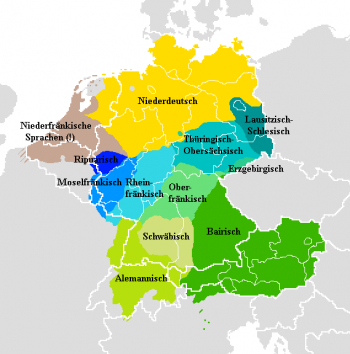 During the 18th century a number of outstanding writers gave modern standard German its modern form – the language of church and state, education and literature. The written standard influenced a corresponding norm for spoken High German, used in education, theater, and broadcasting. There are also many German dialects that differ substantially from standard German, not only in pronunciation but also in grammar.
During the 18th century a number of outstanding writers gave modern standard German its modern form – the language of church and state, education and literature. The written standard influenced a corresponding norm for spoken High German, used in education, theater, and broadcasting. There are also many German dialects that differ substantially from standard German, not only in pronunciation but also in grammar.
The first dictionary of the Brothers Grimm remains the most comprehensive guide to the lexicon of the German language. It was issued in 16 parts between 1852 and 1860.
Grammatical and orthographic rules first appeared in the Duden Handbook in 1880. Later, in 1901, this was declared the standard definition of the German language. Standard German orthography went unrevised until 1998, when the German spelling reform of 1996 was officially promulgated by governmental representatives of Germany, Austria, Liechtenstein, and Switzerland.
Related articles:
The Evolution of the German Language
Exploring the German Language Dialects
Basic German Phrases for Travelers
Essential German Phrases
Overcoming the Hardest Part of Learning German
 12 Food-Related German Idioms - These expressions will have your mouth watering! It’s impossible in one article to discuss all the idioms in German that refer to food. But we can look at some of the most common ones with the literal translation and the meaning. 1. Er glaubt, er bekommt eine Extrawurst Literally: He thinks he gets an extra […]
12 Food-Related German Idioms - These expressions will have your mouth watering! It’s impossible in one article to discuss all the idioms in German that refer to food. But we can look at some of the most common ones with the literal translation and the meaning. 1. Er glaubt, er bekommt eine Extrawurst Literally: He thinks he gets an extra […]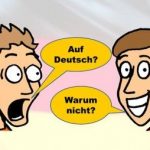 15 false friends in German for English Learners - German and English belong to the group of West Germanic languages and have many words with common language roots. Sometimes you can guess the meaning of the German word because it sounds almost like an English word. This makes learning German language a bit easier for English speakers but it can also create some confusion […]
15 false friends in German for English Learners - German and English belong to the group of West Germanic languages and have many words with common language roots. Sometimes you can guess the meaning of the German word because it sounds almost like an English word. This makes learning German language a bit easier for English speakers but it can also create some confusion […] 30 German Phrases to Maintain the Conversation - People are often a little afraid of getting into awkward situations where they have no clue how to express what they want to say. So, by learning how to express things such as your language level or how to ask for clarification and help with understanding or explaining, you can keep the conversation flowing and […]
30 German Phrases to Maintain the Conversation - People are often a little afraid of getting into awkward situations where they have no clue how to express what they want to say. So, by learning how to express things such as your language level or how to ask for clarification and help with understanding or explaining, you can keep the conversation flowing and […]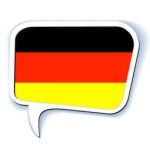 50 Common German Phrases That Are Hilarious in English - Although the German language may seem harsh and hard at first, it is filled with humorous expressions (many of them food-related). However funny expressions and phrases are at first, it’s definitely worth learning a few. See for yourself! German Phrase Literal English Translation Meaning Jetzt geht’s um die Wurst Now it goes around the sausage […]
50 Common German Phrases That Are Hilarious in English - Although the German language may seem harsh and hard at first, it is filled with humorous expressions (many of them food-related). However funny expressions and phrases are at first, it’s definitely worth learning a few. See for yourself! German Phrase Literal English Translation Meaning Jetzt geht’s um die Wurst Now it goes around the sausage […]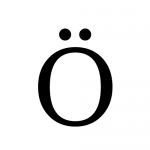 8 Facts About the Umlaut - The German alphabet consists of 26 characters plus 3 umlauts: ä, ö and ü. The two dots above the letters do not indicate an accentuation or emphasis of the syllable (as for instance accent-bearing letters in Spanish or French). Umlauts are used as independent characters in the German language. Whenever the use of umlauts is […]
8 Facts About the Umlaut - The German alphabet consists of 26 characters plus 3 umlauts: ä, ö and ü. The two dots above the letters do not indicate an accentuation or emphasis of the syllable (as for instance accent-bearing letters in Spanish or French). Umlauts are used as independent characters in the German language. Whenever the use of umlauts is […] Basic German Phrases for Travelers - Although most Germans do speak English and you will most likely be understood should you require any assistance, it is much appreciated if you make an effort and speak German. Here is a list of the most basic German phrases you should learn before your visit to Germany. Good luck! Related articles: Germany Exploration: Basic […]
Basic German Phrases for Travelers - Although most Germans do speak English and you will most likely be understood should you require any assistance, it is much appreciated if you make an effort and speak German. Here is a list of the most basic German phrases you should learn before your visit to Germany. Good luck! Related articles: Germany Exploration: Basic […] Bizarre German Idioms and What They Mean - When Language Gets Weird – and Wonderful Let’s be honest – no one does linguistic weirdness quite like the Germans. In what other language can you “have pigs,” “live like a maggot in bacon,” or “stand like an ox in front of a mountain”? These expressions might sound absurd at first, but they’re part of […]
Bizarre German Idioms and What They Mean - When Language Gets Weird – and Wonderful Let’s be honest – no one does linguistic weirdness quite like the Germans. In what other language can you “have pigs,” “live like a maggot in bacon,” or “stand like an ox in front of a mountain”? These expressions might sound absurd at first, but they’re part of […] Common German Acronyms in Texting - Everyone is certainly familiar with short informal words that sprang up relatively recently across the English-speaking web, like LOL (“laugh out loud”), brb (“be right back”), idk (“I don’t know”), etc. German-speaking segment has lots of similar acronyms too: 8tung Achtung – watch out ads alles deine Schuld – all your fault akla? alles klar? […]
Common German Acronyms in Texting - Everyone is certainly familiar with short informal words that sprang up relatively recently across the English-speaking web, like LOL (“laugh out loud”), brb (“be right back”), idk (“I don’t know”), etc. German-speaking segment has lots of similar acronyms too: 8tung Achtung – watch out ads alles deine Schuld – all your fault akla? alles klar? […] Common German Grammar Mistakes to Avoid - There is nothing wrong with making mistakes – the point is to learn from them when you make them so you can avoid making them again and come yet one step closer to proficiency. Two of the common errors that beginners typically make are: first, those garbled sentences that you can avoid only by learning […]
Common German Grammar Mistakes to Avoid - There is nothing wrong with making mistakes – the point is to learn from them when you make them so you can avoid making them again and come yet one step closer to proficiency. Two of the common errors that beginners typically make are: first, those garbled sentences that you can avoid only by learning […]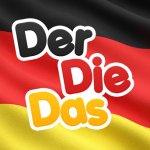 Der, die, das – German Articles - “Every noun has a gender, and there is no sense or system in the distribution; so the gender of each must be learned separately and by heart. There is no other way. To do this one has to have a memory like a memorandum-book.” – Mark Twain, The Awful German Language Indeed, in German, there […]
Der, die, das – German Articles - “Every noun has a gender, and there is no sense or system in the distribution; so the gender of each must be learned separately and by heart. There is no other way. To do this one has to have a memory like a memorandum-book.” – Mark Twain, The Awful German Language Indeed, in German, there […]

